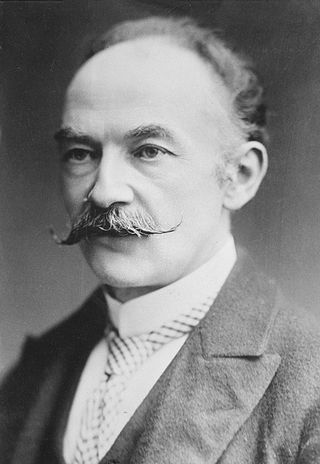
Karl Heinrich Marx was a German philosopher, economist, historian, sociologist, political theorist, journalist, critic of political economy, and socialist revolutionary. His best-known titles are the 1848 pamphlet The Communist Manifesto and the four-volume Das Kapital (1867–1883). Marx's political and philosophical thought had enormous influence on subsequent intellectual, economic, and political history. His name has been used as an adjective, a noun, and a school of social theory.

Thomas Hardy was an English novelist and poet. A Victorian realist in the tradition of George Eliot, he was influenced both in his novels and in his poetry by Romanticism, including the poetry of William Wordsworth. He was highly critical of much in Victorian society, especially on the declining status of rural people in Britain, such as those from his native South West England.

Friedrich Engels was a German philosopher, critic of political economy, historian, political theorist and revolutionary socialist. He was also a businessman, journalist and political activist, whose father was an owner of large textile factories in Salford and Barmen, Prussia.

In economics, a commodity is an economic good, usually a resource, that has full or substantial fungibility: that is, the market treats instances of the good as equivalent or nearly so with no regard to who produced them.

The Pulitzer Prize for Poetry is one of the seven American Pulitzer Prizes awarded annually for Letters, Drama, and Music. It was first presented in 1922, and is given for a distinguished volume of original verse by an American author, published during the preceding calendar year.

Yukio Mishima, born Kimitake Hiraoka, was a Japanese author, poet, playwright, actor, model, Shintoist, nationalist, and founder of the Tatenokai, an unarmed civilian militia. Mishima is considered one of the most important Japanese authors of the 20th century. He was considered for the Nobel Prize in Literature in 1968, but the award went to his countryman and benefactor Yasunari Kawabata. His works include the novels Confessions of a Mask and The Temple of the Golden Pavilion, and the autobiographical essay Sun and Steel. Mishima's work is characterized by "its luxurious vocabulary and decadent metaphors, its fusion of traditional Japanese and modern Western literary styles, and its obsessive assertions of the unity of beauty, eroticism and death", according to author Andrew Rankin.
Collective unconscious refers to the unconscious mind and shared mental concepts. It is generally associated with idealism and was coined by Carl Jung. According to Jung, the human collective unconscious is populated by instincts, as well as by archetypes: ancient primal symbols such as The Great Mother, the Wise Old Man, the Shadow, the Tower, Water, and the Tree of Life. Jung considered the collective unconscious to underpin and surround the unconscious mind, distinguishing it from the personal unconscious of Freudian psychoanalysis. He believed that the concept of the collective unconscious helps to explain why similar themes occur in mythologies around the world. He argued that the collective unconscious had a profound influence on the lives of individuals, who lived out its symbols and clothed them in meaning through their experiences. The psychotherapeutic practise of analytical psychology revolves around examining the patient's relationship to the collective unconscious.

"Snow White" is a 19th-century German fairy tale that is today known widely across the Western world. The Brothers Grimm published it in 1812 in the first edition of their collection Grimms' Fairy Tales, numbered as Tale 53. The original German title was Sneewittchen, a Low German form, but the first version gave the High German translation Schneeweißchen, and the tale has become known in German by the mixed form Schneewittchen. The Grimms completed their final revision of the story in 1854, which can be found in the in 1957 version of Grimms' Fairy Tales.

Beauty and the Beast is a fairy tale written by French novelist Gabrielle-Suzanne Barbot de Villeneuve and published in 1740 in La Jeune Américaine et les contes marins. Her lengthy version was abridged, rewritten, and published by French novelist Jeanne-Marie Leprince de Beaumont in 1756 in Magasin des enfants to produce the version most commonly retold. Later, Andrew Lang retold the story in Blue Fairy Book, a part of the Fairy Book series, in 1889. The fairy tale was influenced by Ancient Greek stories such as "Cupid and Psyche" from The Golden Ass, written by Lucius Apuleius Madaurensis in the second century AD, and The Pig King, an Italian fairytale published by Giovanni Francesco Straparola in The Facetious Nights of Straparola around 1550.

Constance Elaine Trimmer Willis, commonly known as Connie Willis, is an American science fiction and fantasy writer. She has won eleven Hugo Awards and seven Nebula Awards for particular works—more major SF awards than any other writer—most recently the "Best Novel" Hugo and Nebula Awards for Blackout/All Clear (2010). She was inducted by the Science Fiction Hall of Fame in 2009 and the Science Fiction Writers of America named her its 28th SFWA Grand Master in 2011.

Mark Millar is a Scottish comic book writer and television producer who first came to prominence with a run on the superhero series The Authority, published by DC Comics' Wildstorm imprint. Millar has written extensively for Marvel Comics, including runs on The Ultimates, which has been called "the comic book of the decade" by Time magazine and described as a major inspiration for the 2012 film The Avengers by its screenwriter Zak Penn, X-Men, Fantastic Four and Avengers for Marvel's Ultimate imprint, as well as Marvel Knights Spider-Man and Wolverine. In 2006, Millar wrote the Civil War mini-series that served as the centrepiece for the eponymous company-wide crossover storyline and later inspired the Marvel Studios film Captain America: Civil War. The "Old Man Logan" storyline, published as part of Millar's run on Wolverine, served as the inspiration for the 2017 film Logan.

James Dover Grant, primarily known by his pen name Lee Child, is a British author who writes thriller novels, and is best known for his Jack Reacher novel series. The books follow the adventures of a former American military policeman, Jack Reacher, who wanders the United States. His first novel, Killing Floor (1997), won both the Anthony Award and the Barry Award for Best First Novel.
In medical research, social science, and biology, a cross-sectional study is a type of observational study that analyzes data from a population, or a representative subset, at a specific point in time—that is, cross-sectional data.

Kief, sometimes transliterated as keef, also known as ‘’Dust’’ and "Chief" a.k.a cannabis crystals among other names, refers to the pure and clean collection of loose cannabis trichomes, which are accumulated by being sifted from cannabis flowers or buds with a mesh screen or sieve. Like some other cannabis concentrates, it contains a much higher concentration of THC and other psychoactive cannabinoids than that of the cannabis flower from which it is derived. Since it contains a higher level of THC, many consumers choose to add collected kief to their cannabis for a more intense "high"; by the same token, this preparation may induce unwelcome levels of intoxication.

Moon rock or lunar rock is rock originating from Earth's Moon. This includes lunar material collected during the course of human exploration of the Moon, and rock that has been ejected naturally from the Moon's surface and landed on Earth as meteorites.

Dan Slott is an American comic book writer, known for his work on Marvel Comics books such as The Amazing Spider-Man, as well as She-Hulk, Silver Surfer, The Superior Spider-Man, Tony Stark: Iron Man, The Mighty Avengers, and Fantastic Four. His work for DC Comics includes the books Arkham Asylum: Living Hell and Batman Adventures.

Grappler Baki, known as Baki the Grappler in North America, is a Japanese manga series written and illustrated by Keisuke Itagaki. It was originally serialized in the shōnen manga magazine Weekly Shōnen Champion from 1991 to 1999 and collected into 42 tankōbon volumes by Akita Shoten. The story follows teenager Baki Hanma as he trains and tests his fighting skills against a variety of different opponents in deadly, no rules hand-to-hand combat.
This is a table of the total federal tax revenue by state, federal district, and territory collected by the U.S. Internal Revenue Service.

The 2011 Census of India or the 15th Indian Census was conducted in two phases, house listing and population enumeration. The House listing phase began on 1 April 2010 and involved the collection of information about all buildings. Information for National Population Register (NPR) was also collected in the first phase, which will be used to issue a 12-digit unique identification number to all registered Indian residents by Unique Identification Authority of India. The second population enumeration phase was conducted between 9 and 28 February 2011. Census has been conducted in India since 1872 and 2011 marks the first time biometric information was collected. According to the provisional reports released on 31 March 2011, the Indian population increased to 1.21 billion with a decadal growth of 17.70%. Adult literacy rate increased to 74.04% with a decadal growth of 9.21%. The motto of the census was 'Our Census, Our future'.















